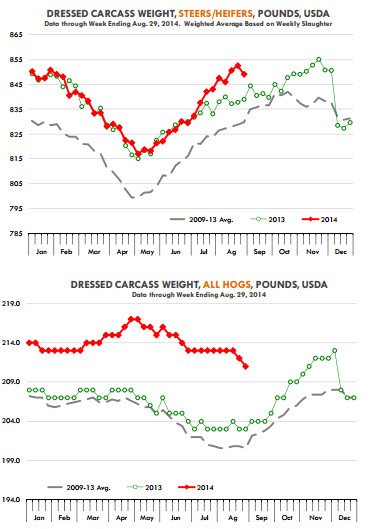



CME: Hog Carcass Weights Remain Heavy
US - Hog slaughter numbers for the week ending September 12 was 2.053 million head, 5.3 per cent lower than a year ago but the largest weekly slaughter since mid March.Fed cattle futures were lower on Friday on reports of lower prices paid for both cattle and boxed beef.
Fed steer trade on Friday was quoted at $157.91/cwt on a live basis (all grades) while live fed heifers were priced at $158.12/cwt. These prices were a couple of dollars lower than earlier in the week and market participants once again were contemplating whether cattle prices were due for a correction as cattle supplies are expected to be more available in the coming weeks.
USDA will issue its cattle on feed numbers at the end of this week and we will provide a summary of market analyst expectations ahead of the report. We think the total number of cattle on feed as of 1 September will likely be around 0.8 per cent lower than a year ago, with more market ready cattle available than at the same time last year.
One indication of this trend can be seen in the carcass weight numbers for cattle. August steer weights (based on weekly data) averaged about 878 pounds per carcass, about 12 pounds (+1.4 per cent) more than the same period a year ago. Heifer weights during the same period were 795 pounds per carcass, 4 pounds or 0.5 per cent higher than a year ago.
The increase in weights has helped offset lower slaughter numbers but the overall impact has been small given the big decline in cattle kills. One thing that is interesting looking at the cattle supply flow is the sharp decline in the number of heifers coming to market.
We have noted it often that as producers start looking at herd rebuilding, reduced heifer availability will be one of the key drivers for a reduction in supply. The slaughter data appears to support that view even as the 1 July inventory showed limited heifer retention. For the four complete August weeks (4 August - 31 August), steer slaughter was reported at 1.252 million head, down 29,343 head (-2.3 per cent)compared to the same period a year ago (four full August weeks in 2013).
Heifer slaughter during the reference period was 649,449 head, down 85,151 head (-11.6 per cent) compared to a year ago. In all, during the four August weeks fed cattle slaughter declined by 114,490 head and the lower heifer numbers contributed about 3/4 of the reduction. The reduction in heifer numbers available for slaughter will likely remain a driver for supplies going into the winter time period.
We get only quarterly data as to the composition of feed lot placements (heifers vs. steers) and we suspect that heifer placements during the summer months continued to decline at a faster pace than the overall reduction in placements. The calf crop in 2014 also is pegged to be lower than the previous year. As a result, overall cattle availability for placement remains quite limited and feed lots will continue to overfeed their stock and seek to maximize the pounds they put on the carcass rather than be faced with empty pens.
Hog slaughter numbers for the week ending September 12 was 2.053 million head, 5.3 per cent lower than a year ago but the largest weekly slaughter since mid March. Hog carcass weights remain extremely heavy even as overall weights were lower in the second half of August as producers were more aggressive in marketing hogs. Based on the MPR data, we calculate the average hog carcass weights for week ending September 12 at 212.3 pounds per carcass, 8.2 pounds (+3.8 per cent) higher than a year ago.
Carcass weights of producer owned hogs averaged 212.7 pounds, or 9.4 pounds (+4.5 per cent) higher than a year ago while packer owned hogs averaged 212 pounds, 5.9 pounds (+2.4 per cent) higher than last year. Normally hog carcass weights trend higher in the fall but that may not be the case this year.
Keep in mind that last year weights were sharply higher in October as producers had to contend with the disruption to the USDA pricing data and thus delayed some of their marketings. Also, weights were unusually high during the summer due to the PEDv supply disruptions and as more hogs become available, producers will have to move some of their stock along to make room.









